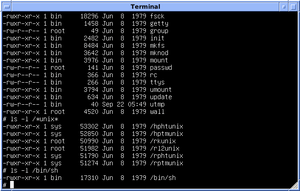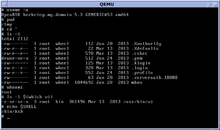Bourne shell
|
Bourne shell interaction on Version 7 Unix | |
| Original author(s) | Stephen Bourne |
|---|---|
| Initial release | 1977 |
| Operating system | Unix |
| Type | Unix shell |
| License | [under discussion] |
The Bourne shell (sh) is a shell, or command-line interpreter, for computer operating systems.
The Bourne shell was the default shell for Unix Version 7. Most Unix-like systems continue to have /bin/sh—which will be the Bourne shell, or a symbolic link or hard link to a compatible shell even when other shells are used by most users.
Developed by Stephen Bourne at Bell Labs, it was a replacement for the Thompson shell, whose executable file had the same name—sh. It was released in 1977 in the Version 7 Unix release distributed to colleges and universities. Although it is used as an interactive command interpreter, it was also intended as a scripting language and contains most of the features that are commonly considered to produce structured programs.
It gained popularity with the publication of The Unix Programming Environment by Brian Kernighan and Rob Pike—the first commercially published book that presented the shell as a programming language in a tutorial form.
History

Origins
Coding started in 1976[1]
First appearing in Version 7 Unix,[2] the Bourne shell superseded the Mashey shell.
Among the primary goals were:[3]
- To allow shell scripts to be used as filters.
- To provide programmability including control flow and variables.
- Control over all input/output file descriptors.
- Control over signal handling within scripts.
- No limits on string lengths when interpreting shell scripts.
- Rationalize and generalize string quoting mechanism.
- The environment mechanism. This allowed context to be established at startup and provided a way for shell scripts to pass context to sub scripts (processes) without having to use explicit positional parameters.
Features of the original version
Features of the UNIX Version 7 Bourne shell include:
- Scripts can be invoked as commands by using their filename
- May be used interactively or non-interactively
- Allow both synchronous and asynchronous execution of commands
- supports input and output redirection and pipelines
- provides a set of built-in commands
- provides flow control constructs, quotation facilities, and functions.
- typeless variables
- provides local and global variable scope
- scripts do not require compilation before execution
- does not have a goto facility, so code restructuring may be necessary
- Command substitution using back quotes:
`command`. - Here documents using
<<to embed a block of input text within a script. - "
for ~ do ~ done" loops, in particular the use of$*to loop over arguments. - "
case ~ in ~ esac" selection mechanism, primarily intended to assist argument parsing. -
shprovided support for environment variables using keyword parameters and exportable variables. - It contains strong provisions for controlling input and output and in its expression matching facilities.
The Bourne shell also was the first to feature the convention of using file descriptor 2> for error messages, allowing much greater programmatic control during scripting by keeping error messages separate from data.
Stephen Bourne's coding style was influenced by his experience with the ALGOL 68C compiler[2] that he had been working on at Cambridge University. In addition to the style in which the program was written, Bourne reused portions of ALGOL 68's "if ~ then ~ elif ~ else ~ fi", "case ~ in ~ esac" and "for ~ while ~ do ~ od" (using done instead of od) clauses in the common Unix Bourne shell syntax. Moreover, – although the v7 shell is written in C – Bourne took advantage of some macros[4] to give the C source code an ALGOL 68 flavor. These macros (along with the finger command distributed in Unix version 4.2BSD) inspired the IOCCC – International Obfuscated C Code Contest.[5]
Features introduced after 1979
Over the years, the Bourne shell was enhanced at AT&T. The various variants are thus called like the respective AT&T Unix version it was released with (some important variants being Version7, SystemIII, SVR2, SVR3, SVR4). As the shell was never versioned, the only way to identify it was testing its features.[6]
Features of the Bourne shell versions since 1979 include:[7]
- Built-in
testcommand – System III shell (1981) - # as comment character – System III shell (1981)
- Colon in parameter substitutions "${parameter:=word}" – System III shell (1981)
-
continuewith argument – System III shell (1981) -
cat <<-EOFfor indented here documents – System III shell (1981) - Functions and the
returnbuiltin – SVR2 shell (1984) - Built-ins
unset,echo,type– SVR2 shell (1984) - Source code de-ALGOL68-ized – SVR2 shell (1984)
- Modern "
$@" – SVR3 shell (1986) - Built-in
getopts– SVR3 shell (1986) - Cleaned up parameter handling allows recursively callable functions – SVR3 shell (1986)
- 8-bit clean – SVR3 shell (1986)
- Job control – SVR4 shell (1989)
- Multi-byte support – SVR4 shell (1989)
Variants
Korn shell
The Korn shell (ksh) written by David Korn based on the original Bourne Shell source code,[8] was a middle road between the Bourne shell and the C shell. Its syntax was chiefly drawn from the Bourne shell, while its job control features resembled those of the C shell. The functionality of the original Korn Shell (known as ksh88 from the year of its introduction) was used as a basis for the POSIX shell standard. A newer version, ksh93, has been open source since 2000 and is used on some Linux distributions. A clone of ksh88 known as pdksh is the default shell in OpenBSD.
Relationship to other shells
C shell
Bill Joy, the author of the C shell, criticized the Bourne shell as being unfriendly for interactive use,[9] a task for which Stephen Bourne himself acknowledged C shell's superiority. Bourne stated, however, that his shell was superior for scripting and was available on any Unix system,[10] and Tom Christiansen also criticized C shell as being unsuitable for scripting and programming.[11]
Almquist shells
Due to copyright issues surrounding the Bourne Shell as it was used in historic CSRG BSD releases, Kenneth Almquist developed a clone of the Bourne Shell, known by some as the Almquist shell and available under the BSD license, which is in use today on some BSD descendants and in low-memory situations. The Almquist Shell was ported to Linux, and the port renamed the Debian Almquist shell, or dash. This shell provides faster execution of standard sh (and POSIX-standard sh, in modern descendants) scripts with a smaller memory footprint than its counterpart, Bash. Its use tends to expose bashisms – bash-centric assumptions made in scripts meant to run on sh.
Other shells
Bash (the Bourne-Again shell) was later developed for the GNU project and incorporates features from the Bourne shell, csh, and ksh. It is meant to be POSIX-compliant.
rc was created at Bell Labs by Tom Duff as a replacement for sh for Version 10 Unix. It is the default shell for Plan 9 from Bell Labs. It has been ported to UNIX as part of Plan 9 from User Space.
Usage
The Bourne shell was once standard on all branded Unix systems, although historically BSD-based systems had many scripts written in csh. As the basis of POSIX sh syntax, Bourne shell scripts can typically be run with Bash or dash on GNU/Linux or other Unix-like systems.
See also
References
- ↑ https://www.bsdcan.org/2015/schedule/events/612.en.html Stephen Bourne Keynote for BSDCan 2015
- 1 2 McIlroy, M. D. (1987). A Research Unix reader: annotated excerpts from the Programmer's Manual, 1971–1986 (PDF) (Technical report). CSTR. Bell Labs. 139.
- ↑ "The A-Z of Programming Languages: Bourne shell, or sh" March 2009, Computerworld
- ↑ Bourne, Steve (12 January 1979). "mac.h – Macros used by Bourne to structure C like Algol68C". AT&T Corporation. Retrieved 9 September 2006.
- ↑ Landon Curt Noll, Simon Cooper, Peter Seebach and Leonid A. Broukhis (2004). "The IOCCC FAQ – Q/A: How did the IOCCC get started?". www.ioccc.org. Retrieved 9 September 2006.
- ↑ Bourne Shell release testing script from Sven Mascheck
- ↑ History of the Bourne Shell family
- ↑ Korn, David G. (October 26, 1994), "ksh - An Extensible High Level Language", Proceedings of the USENIX 1994 Very High Level Languages Symposium, USENIX Association, retrieved February 5, 2015,
Instead of inventing a new script language, we built a form entry system by modifying the Bourne shell, adding built-in commands as necessary.
- ↑ An Introduction to the C shell by Bill Joy.
- ↑ Bourne, Stephen R. (October 1983). "The Unix Shell". BYTE. p. 187. Retrieved 30 January 2015.
- ↑ Tom Christiansen (28 September 1995). "Csh Programming Considered Harmful". Retrieved 17 February 2014.
External links
| Wikibooks has a book on the topic of: Bourne Shell Scripting |
- The individual members of "The Traditional Bourne Shell Family"
- Characteristical common properties of the traditional Bourne shells"
- Historical C source code for the Bourne shell using mac.h macros from 1979
- Original Bourne Shell documentation from 1978
- A port of the "heirloom" SVR4 Bourne shell from OpenSolaris to some other Unix-like systems
- Bourne Shell Tutorial (syntax)
- Faqs shell differences
- Howard Dahdah, The A–Z of Programming Languages: Bourne shell, or sh — An in-depth interview with Steve Bourne, creator of the Bourne shell, or sh, Computerworld, 5 March 2009.

